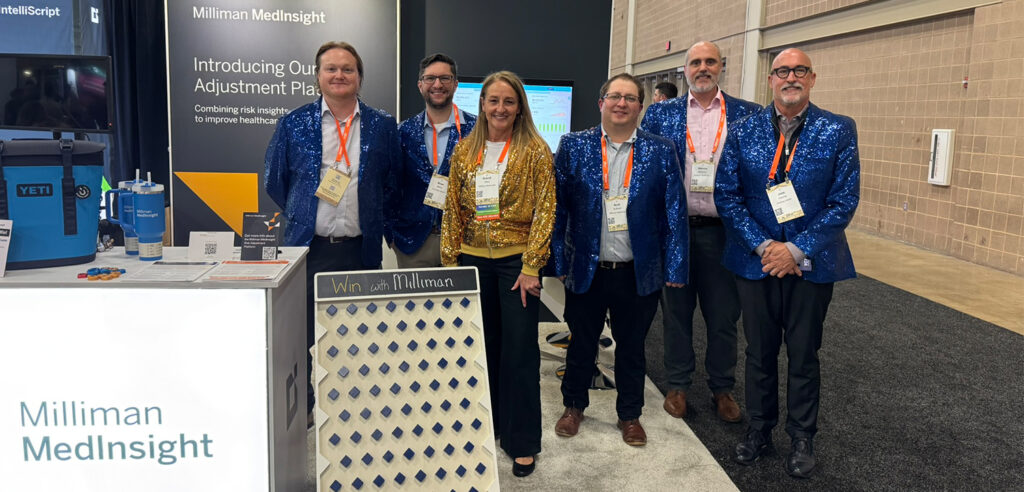The RISE National 2025 conference made one thing clear: advanced technologies like artificial intelligence (AI) are not just refining risk adjustment strategies—they are dramatically accelerating insights and deliverables. The event emphasized the urgent need for interoperability and smooth data integration, in tandem with innovative measures aimed at minimizing provider abrasion within value-based care (VBC) frameworks.
If you missed us in San Antonio, we’ll recap key insights from this year’s conference and explore the advancements reshaping how healthcare organizations handle risk adjustment. We will also demonstrate how the new Milliman MedInsight® Risk Adjustment Platform is at the forefront of this transformative journey.

1. Minimizing provider abrasion in value-based care
The shift to value-based care also requires minimizing provider abrasion, allowing healthcare professionals to concentrate on patient care instead of being encumbered by administrative burdens. One of the most effective ways to achieve this is through the integration of advanced, scalable technology platforms. These platforms not only streamline communication but also deliver critical information for care coordination efficiency. For instance, an integrated technology solution can centralize patient data, making it easily accessible to all stakeholders involved in a patient’s care. This reduces the need for repetitive data entry. increases data transparency, and ensures that all team members have the most up-to-date information, leading to greater quality of care and potentially higher HEDIS scores.
2. The importance of interoperability & data sharing
Bridging the gap between claim data and EHR data is crucial for effectively assessing the sufficiency of documentation. This integration can significantly streamline workflow processes and enhance overall accuracy. By aligning claim data with detailed medical records, healthcare providers and insurance companies ensure that all necessary information is readily available and up to date. This not only provides a more holistic view of the patient but also allows for more thorough and accurate evaluations of the documentation, ensuring that all required elements are present and correct.
Leveraging EHR is particularly vital in this context. EHRs contain a wealth of information that, when properly utilized, can greatly improve risk stratification. However, the value of this data is often limited by siloed systems and incompatible data formats. Interoperability standards help break down these barriers, allowing for the seamless flow of information between different healthcare providers and systems. This not only enhances the accuracy of risk adjustment but also supports more informed clinical decision-making, ultimately leading to better patient outcomes.
3. AI-driven strategies for risk adjustment efficiency
Integrating artificial intelligence (AI) into risk adjustment is revolutionizing how healthcare organizations identify, track, and manage patient risks, leading to more accurate and efficient outcomes. Reviewing charts and coding accuracy has historically been a very manual and labor-intensive process for plans. By analyzing vast amounts of data —including historical medical records and real-time electronic health records (EHRs)—AI algorithms can help organizations to intervene proactively, potentially preventing or mitigating serious health issues before they escalate. It also facilitates more precise risk scoring, helping insurers and healthcare providers allocate resources more effectively and ensure appropriate care.
AI-driven tools are also transforming workflows and the documentation process, a task that has long burdened healthcare professionals. These tools automate the extraction and analysis of data from EHRs, reducing the time and effort required for manual documentation. This automation streamlines workflows, minimizes the risk of errors, and ensures that risk adjustment is based on accurate and up-to-date information. Without the right tools and processes, healthcare organizations may fall short on closing critical coding and care gaps. This can lead to considerable errors such as inaccurate risk scoring, inefficient Hierarchical Condition Category (HCC) documentation and coding, and undocumented or untreated conditions.
4. Optimizing quality, efficiency, & outcomes with the MedInsight Risk Adjustment Platform
The newly released Milliman MedInsight Risk Adjustment Platform is specifically designed to streamline processes, increase data accuracy, and ultimately enhance patient outcomes. Among its key strengths is the capacity to efficiently and accurately capture all pertinent patient information. By seamlessly integrating and consolidating data within established workflows, it removes the need for labor-intensive manual steps and provides a unified view of each patient’s records. This not only expedites the retrieval of stored queries and reports but also maintains an extensive audit trail, thereby preserving data integrity and improving the accuracy of both clinical and financial decision-making over time.
In VBC models, where administrative burdens can take a toll on the workforce, the platform’s customizable dashboards deliver clear, actionable insights crafted to meet the unique needs of both payers and providers. For payers, this translates into greater transparency around risk adjustment performance; for providers, it ensures access to the information required to optimize patient care and elevate outcomes. For example, the Risk Adjustment Platform differentiates isolated, one-off coding errors from broader under-coding or miscoding trends that may signal a need for targeted training. This heightened visibility supports a more proactive approach on compliance and financial optimization, allowing resources to be deployed more effectively.
Furthermore, building on our established benchmarks and financial groupers—now known as Data Science Feature Enrichment—we’re expanding the reach of crucial financial data to a broader range of information users. At the RISE National 2025 conference, we confirmed that contextualizing complex risk adjustment workflows with high-quality financial data and benchmarks is foundational to success for any line of business. We’re especially excited about this validation considering our growing adoption across multiple platforms, such as the Value-Based Performance Management (VBPM) module in Epic’s Healthy Planet. Milliman MedInsight is proud to empower providers with the most trusted data quality, helping them achieve contract success with confidence.
The Milliman MedInsight difference
The combined strength of Milliman MedInsight’s advanced analytics and Milliman’s deep financial and industry expertise creates a uniquely powerful solution for transforming risk adjustment strategies. This partnership goes beyond simply integrating data; it delivers tailored insights that help organizations better identify, monitor, and mitigate risk factors across patient populations. By leveraging Milliman’s decades of experience in financial modeling and industry best practices, organizations can trust the performance benchmarks and predictive models generated by Milliman MedInsight’s analytics.
The Risk Adjustment Platform offers several key advantages:
1. Unrivaled data foundation: The Milliman MedInsight Risk Adjustment Platform leverages Milliman’s industry-leading normative data assets, covering 100% of Medicare fee-for-service (FFS), 100% of Medicare Advantage, 100% of Medicaid, and nearly 50% of the Commercial market. This extensive data repository provides unmatched competitive insights into payers and providers at the market and even NPI levels.
2. Advanced benchmarks and real-time performance modeling: With Milliman’s utilization benchmarks—enhanced by HCC, quality measures (including STARS), and financial indicators—the platform enables real-time performance modeling. This ensures precision in assessments and helps users stay ahead of evolving regulatory requirements with clinically-driven, robust benchmarks.
3. Integrated risk workflow and AI-powered efficiency: Milliman MedInsight’s platform offers a comprehensive risk workflow solution, covering everything from prospective and retrospective coding to RADV audits. Advanced AI supports recapture and suspect reporting, while a seamless, user-friendly interface integrates with over 2,000 EHR/EMRs. This empowers providers with prescriptive insights and streamlines work allocation, improving efficiency and enhancing care at the point of service.
Exploring the Risk Adjustment Platform further
Schedule a call: Connect with one of our healthcare analytics experts.
Visit our website: Learn more about our Risk Adjustment Platform, a comprehensive, end-to-end risk adjustment solution.
Watch the webinar: Discover how to optimize risk adjustment, RADV audits, and HEDIS gap closures in our “Integrated risk adjustment solutions: Enhancing reimbursement and patient care” webinar.
